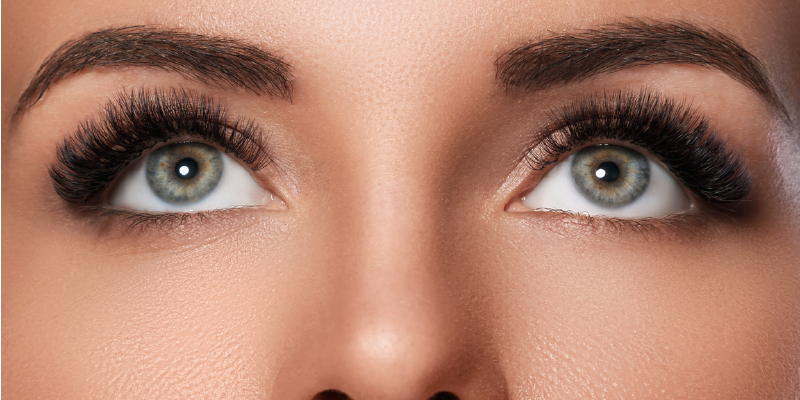What Is Computer Vision Syndrome?
Almost everyone uses a computer on a daily basis. Whether it’s for work, school, or even just for fun, we all are guilty of staring at a computer screen on the regular. We spend so much time staring at our screens that our eyes can sometimes suffer the consequences. Computer Vision Syndrome (CVS) refers to a large spectrum of eye and vision-related problems caused by prolonged use of different technologies with screens (computers, tablets, cell phones, etc.). Luckily, there are ways you can use technology safely and to promote healthy vision.
Defining Computer Vision Syndrome

Computer Vision Syndrome, sometimes referred to as Digital Eye Strain, is not one specific vision-related problem. It is common to experience eye strain and discomfort after prolonged use of a computer, and staring at a tablet or phone screen for hours on end. The American Optometric Association (AOA) states on their website that the average American worker spends around seven hours a day working on their computer at the office, or even working from home. Most of the time, CVS occurs when “the visual demands of the task exceed the visual abilities of the individual to comfortably perform them.” You are most susceptible to straining your eyes if you use a computer or look at a screen for two or more consecutive hours a day.
The U.S. National Library of Medicine posted an article titled, Understanding and Preventing Computer Vision Syndrome that highlights the complexities of your eyes and how important it is to take proper care of them – in this instance, it is practicing safe digital screen use. There are three main potential mechanisms that can cause the symptoms of CVS: extraocular mechanism, accommodative mechanism, and ocular surface mechanism. Extraocular mechanisms cause symptoms within the musculoskeletal system (back pain, headaches, stiffness, back and shoulder pain). These symptoms can occur when the computer screen is improperly placed in front of you.
Accommodative mechanism is a little more ever than extraocular mechanism because the symptoms are not as easy to correct. Accommodative mechanism causes blurred vision, double vision, presbyopia, myopia, and a slowed focus change. (Source). Slight accommodative problems are usually quite common, regardless of a person’s digital screen usage, but the problems can worsen with prolonged screen use. Finally, there is ocular surface mechanism, which can cause dry eyes, redness, a gritty sensation when you blink, and a burning sensation after an extended period of computer use. (Source).
How Looking At Screens Can Damage Your Eyes

When you view a computer or digital screen, your eyes have to work harder than they do normally. So how is looking at things on a digital screen any different from reading a book? Well, it has everything to do with the screen of the device: the letters are less sharply defined, there isn’t as much of a contrast between the background and the words, and there is often a glare which can make the eyes work harder to see what is on the screen. Overall, there is a different visual demand and stress on your eyes when looking at a digital screen. Computer and other digital screens are made up of pixels, therefore this can make the words on the screen less sharp and not quite as easy to focus on as the words printed in ink. This is worsened with low resolution screens and images.
The distance and angle at which you view a computer or digital screen can also be the cause of damage to your eyes. Even if you have eyeglasses or corrective contact lenses, the distance at which you view a digital screen still may not be the safest distance. In most instances, CVS occurs when the demands of viewing a digital screen outweigh the abilities of our eyes.
Explaining Blue Light

The website Prevent Blindness outlines Blue Light and how it can damage your eyes. Sunlight is made of red, orange, yellow, green, blue, indigo, and violet light (yes, rainbows!) but when those colors combine, it becomes white light. However, each of these colored lights has its own wavelength and energy. Rays that are on the red spectrum have long wavelengths but less energy. Alternatively, blue rays have very short wavelengths but very strong energy. Light that appears white can actually have a very strong blue light component to it. So what do we use everyday that contains blue light? Fluorescent lights, LED lights, LED screen TVs, and digital screens (computers, phones, and tablets). Blue light is actually not all bad – there are some positive results from the use of blue light. Blue light can boost alertness, cognitive memory function, and can even elevate your mood (SAD lamps use blue light). Blue light can also be utilized to create a regular sleep pattern – this is called circadian rhythm.
Computer Vision Syndrome Symptoms
The American Optometric Association lists the following symptoms as a result of Computer Vision Syndrome:
- headaches
- eye strain
- blurred vision
- dry eyes
- neck and shoulder pain
They go on to list the possible things that can cause CVS:
- poor lighting
- a glare on the computer screen
- improper viewing distances
- poor posture
- uncorrected vision problems
Many of the symptoms are only temporary, and will go away within a short period of time. But it is also important to note that sometimes you can experience decreased visual abilities, like blurred vision, even after you stop use of a computer. At this point, it is important to contact and consult and eye doctor about the proper steps in remedying this problem. Luckily, for the most part, all of these problems and symptoms can be easily corrected or prevented.
There is also something called eye fatigue. WebMD describes eye fatigue as a common condition where your eyes are burning, itchy, and tired. Reading, writing, and driving are the main causes of eye fatigue. Bright lights, and alternatively, lights that are too dim can strain your eyes and make them feel tired.
How Computer Vision Syndrome Is Diagnosed
There are a few ways that an eye doctor can diagnose the symptoms of CVS through an eye examination and testing.
- Patient history – the doctor can determine any symptoms by using the patient’s medical history. This includes any present health issues, medications taken, and environmental factors that may be related to the symptoms or CVS.
- Visual acuity measurement – a process that is used to access how badly the vision may be affected.
- A refraction – this is used to determine the appropriate lens “power” needed to compensate for any refractive errors with the vision (including nearsightedness, farsightedness, and astigmatism).
- Focus testing – this tests how the eyes focus, move and work together. In order to see properly and obtain a clear, focused image, the eyes need to work in unison. This test will look for problems in the way the eyes focus and an individual’s ability to use both eyes together. (Source).
Proper Eye Care and Solutions
Some ways to prevent ocular symptoms are to take a short break, stretch your muscles, and to walk around the office. Frequent and short breaks are an easy way to prevent accommodative symptoms with the eyes. Dry eyes can be prevented with artificial tears and lubricants, like Cliradex. The following are some easy ways to maintain healthy digital screen use:
- Sleep – when you keep long hours, your eyes tend to strain even more. Sleep “refreshes” your eyes and replenishes the essential nutrients that your eyes need to see comfortably and properly.
- Computer screen distance – placing your computer 20 to 26 inches away and slightly below eye level creates a comfortable viewing distance for your eyes. Making sure your screens are smudge and glare free are also good ways to ensure that you won’t strain your eyes as much.
- Environment – get a comfortable, adjustable chair and take into consideration surrounding factors like lighting.
- Work habits – WebMD mentions the “20-20-20” rule. This suggests that every 20 minutes you should look at something 20 feet away for 20 seconds. You can also take regular breaks from working at the computer and simple things like blinking often.
- Eye care routine – apply a warm washcloth if your eyes feel tired and dry (make sure to keep your eyes closed), use of artificial tears (like Cliradex), and a humidifier to create an environment suitable for preventing dry eyes.




